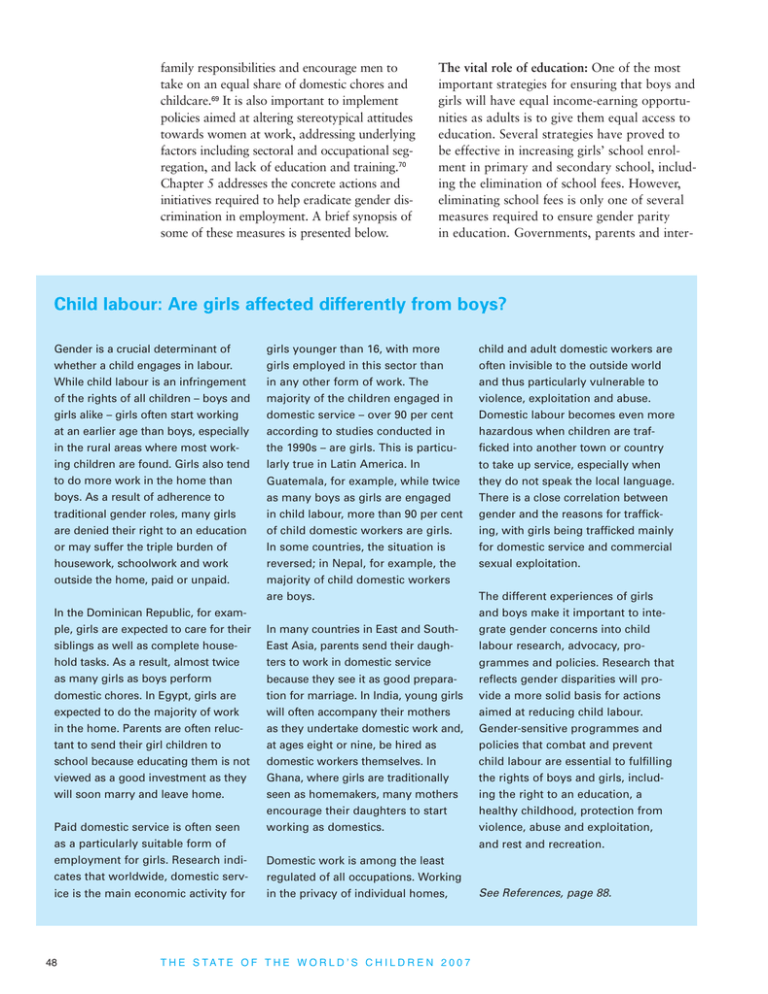Child labour: Are girls affected differently from boys?
advertisement

family responsibilities and encourage men to take on an equal share of domestic chores and childcare.69 It is also important to implement policies aimed at altering stereotypical attitudes towards women at work, addressing underlying factors including sectoral and occupational segregation, and lack of education and training.70 Chapter 5 addresses the concrete actions and initiatives required to help eradicate gender discrimination in employment. A brief synopsis of some of these measures is presented below. The vital role of education: One of the most important strategies for ensuring that boys and girls will have equal income-earning opportunities as adults is to give them equal access to education. Several strategies have proved to be effective in increasing girls’ school enrolment in primary and secondary school, including the elimination of school fees. However, eliminating school fees is only one of several measures required to ensure gender parity in education. Governments, parents and inter- Child labour: Are girls affected differently from boys? Gender is a crucial determinant of whether a child engages in labour. While child labour is an infringement of the rights of all children – boys and girls alike – girls often start working at an earlier age than boys, especially in the rural areas where most working children are found. Girls also tend to do more work in the home than boys. As a result of adherence to traditional gender roles, many girls are denied their right to an education or may suffer the triple burden of housework, schoolwork and work outside the home, paid or unpaid. In the Dominican Republic, for example, girls are expected to care for their siblings as well as complete household tasks. As a result, almost twice as many girls as boys perform domestic chores. In Egypt, girls are expected to do the majority of work in the home. Parents are often reluctant to send their girl children to school because educating them is not viewed as a good investment as they will soon marry and leave home. Paid domestic service is often seen as a particularly suitable form of employment for girls. Research indicates that worldwide, domestic service is the main economic activity for 48 girls younger than 16, with more girls employed in this sector than in any other form of work. The majority of the children engaged in domestic service – over 90 per cent according to studies conducted in the 1990s – are girls. This is particularly true in Latin America. In Guatemala, for example, while twice as many boys as girls are engaged in child labour, more than 90 per cent of child domestic workers are girls. In some countries, the situation is reversed; in Nepal, for example, the majority of child domestic workers are boys. In many countries in East and SouthEast Asia, parents send their daughters to work in domestic service because they see it as good preparation for marriage. In India, young girls will often accompany their mothers as they undertake domestic work and, at ages eight or nine, be hired as domestic workers themselves. In Ghana, where girls are traditionally seen as homemakers, many mothers encourage their daughters to start working as domestics. Domestic work is among the least regulated of all occupations. Working in the privacy of individual homes, T H E S TAT E O F T H E W O R L D ’ S C H I L D R E N 2 0 0 7 child and adult domestic workers are often invisible to the outside world and thus particularly vulnerable to violence, exploitation and abuse. Domestic labour becomes even more hazardous when children are trafficked into another town or country to take up service, especially when they do not speak the local language. There is a close correlation between gender and the reasons for trafficking, with girls being trafficked mainly for domestic service and commercial sexual exploitation. The different experiences of girls and boys make it important to integrate gender concerns into child labour research, advocacy, programmes and policies. Research that reflects gender disparities will provide a more solid basis for actions aimed at reducing child labour. Gender-sensitive programmes and policies that combat and prevent child labour are essential to fulfilling the rights of boys and girls, including the right to an education, a healthy childhood, protection from violence, abuse and exploitation, and rest and recreation. See References, page 88.


